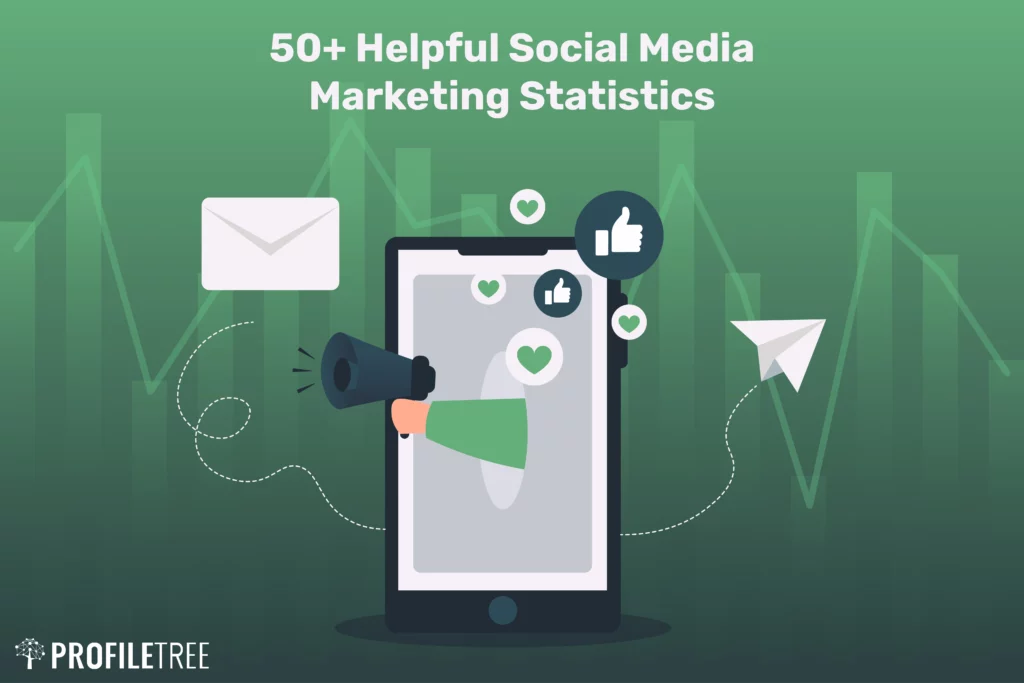Knowing how to optimise social media for your business effectively can ensure you get the most out of your platforms.
It can be difficult to know where to start with how to optimise social media for your business but we have put together a list of simple manageable steps for your business.
We will look at how to improve your brands visibility on social media, how to get more engagement for your posts and how to encourage audience feedback.
Table of Contents
What Is Social Media Optimisation?
Social media optimisation is the process of improving your social posts and your whole social media presence to achieve better results, faster follower growth, higher levels of engagement, more clicks or conversions, etc.
Knowing how to optimise social media for your business can involve many different techniques and tactics.

- Simple improvements on individual posts e.g. asking an engaging question in a post caption or picking a more eye catching visual
- Higher level improvements, e.g. redefining your brand’s tone of voice on social media
Social media optimisation should be based on current performance, audience and competitor research and insights gathered through social listening.
Looking at how to optimise social media for your business will give you an opportunity to analyse and adjust your current social media strategy for the better.

Benefits of Social Media Optimisation
Here’s what knowing how to optimise social media for your business can do for your social media:
- Strengthen your online presence
- Connect and engage with your audience better
- Increase brand awareness on social media
- Improve reach on social media
- Improve the quality of your leads from social media
- Sell more of your products and services through social channels
Nine steps to optimise social media for your business
To the untrained eye, a brand’s social media presence might seem effortless, but there’s a lot that goes on behind the scenes to ensure that social media accounts are being used as effectively as possible.
1. Post at the right time
To be successful on social media, you need to consistently post content at peak times for your business.
Figuring out the most optimal time to post on social media is hard work, social media insights can massively help with this.
Use an online scheduling tool that has a best time to publish feature and take advantage of posting your social media content when your audience is most likely to be online and engage with your posts.
2. Tidy up your bios
Your social media bio is potentially one of the first things a new visitor or potential lead sees when visiting your profile page. So, it’s essential to have this as polished as possible. Important information to always include:
- Who you are
- What your business does
- What you do
- Your brand’s tone
- Call to action/how someone can get in touch with you
You might also want to consider including a call to action in your bio that encourages visitors to click on a link to your website, an online store, or a key landing page. Feel free to swap out the link in your bio regularly with your most up-to-date, highest-quality content or a key landing page that you need to drive traffic towards.
3. Make sure your images are the right size for each platform
There’s nothing worse than visiting a social profile and the images have been cut off. Your brand’s look is everything. So, make sure that your images are visually appealing, look professional and most importantly are the right size for each platform.
Ensure that your profile picture is high quality, clear and sized correctly. Company logos are usually preferable and we recommend your profile pictures to be consistent across all social media platforms. This will help with brand recognition.
4. Post the correct amount
You don’t want to bombard your audience with posting non-stop, and you also don’t want to post so little that you fall off their radar. Finding your optimal social media posting schedule is essential to driving more engagement and conversations with your brand.
5. Review your social media strategy

Take the time to look over your current social media strategy and think about the following areas:
- Are you hitting your goals and objectives?
- Do your social media goals still align with your overarching marketing strategy?
- Are you posting the right types of content? For example, images, videos, text-only, or a mixture of all three?
- Are your posts receiving engagement from your target audience?
6. Always keep your audience top of mind
Not all audiences are the same. Spend some time looking into the demographics to optimise your social media content for the right groups.
For example, if you’re targeting an audience in England, you want to use the correct language. Similarly, if you’re targeting an audience in America, you might want to tailor your copy to suit.
7. Create consistency with your username
Having a consistent username across all social media platforms will help with brand recognition. It is essential to be identifiable easily, so we always recommend having the same username with little to no variation of it.
8. Write catchy headlines and captions
It’s important to maintain your brand voice throughout your posts and captions to maintain a consistent presence.
It’s also important to remember copy for each social media platform will be different in order to suit different target audiences.
9. Add tags to your posts
If your social media post features another brand or a customer, it’s best practice to tag that person in your post. This can help to build connections and relationships, start conversations and encourage engagement.
Content Strategy & Planning: Mastering the Social Media Calendar
Planning is the cornerstone of successful social media engagement. Before diving headfirst into posting, taking the time to strategize and develop a content calendar will ensure consistency, reach your target audience effectively, and ultimately, achieve your business goals. Here’s why planning matters and how to do it right:
1. Importance of a Content Calendar:
- Consistency is Key: Frequent, planned posts keep your brand visible and top-of-mind for your audience. A calendar helps stay consistent and avoid sporadic activity.
- Reaching Your Audience: Planning allows you to post at optimal times when your target audience is most active, maximizing reach and engagement.
- Organized Workflow: Planning saves time and ensures smooth content creation by anticipating needs and deadlines.
- Goal-Oriented Approach: Aligning your content calendar with your overall business goals ensures your social media efforts contribute to a broader strategy.
2. Identifying Your Target Audience:
- Know Your Personas: Who are you trying to reach? Define your ideal customer demographics, interests, and behavior patterns.
- Tailored Content: Understanding your audience allows you to create content that resonates with their needs and preferences, increasing engagement.
- Platform Specific: Different platforms attract different audiences. Tailor content formats and topics to each platform based on your target audience’s preferred channels.
3. Content Diversification: Beyond Text and Images:
- Engage Diverse Audiences: Not everyone consumes content the same way. Offer a variety of formats like videos, infographics, live streams, polls, and quizzes to cater to different preferences.
- Boost Reach and Attention: Diverse formats add visual interest, break up text-heavy content, and enhance accessibility for users with different learning styles.
- Leveraging Trends: Consider incorporating trending topics, challenges, and hashtags to increase visibility and spark audience participation.
4. Trendjacking & Staying Relevant:
- Keep Your Finger on the Pulse: Monitor industry news, trending topics, and social media conversations to identify relevant themes and opportunities.
- Infuse Newness into Your Content: Adapt your content strategy to incorporate trending topics and keep your brand fresh and exciting.
- Authenticity is Key: Don’t force trends; find opportunities that genuinely align with your brand identity and message.
Remember: Planning doesn’t have to be rigid. Allow for flexibility to adapt to emerging trends and audience feedback. The key is to have a solid foundation and direction to guide your content creation efforts. By implementing these strategies, you can build a content calendar that drives engagement, reaches your target audience, and ultimately helps you achieve your social media goals.
Paid Advertising & Social Media Marketing: Boosting Your Reach and Results
While organic social media engagement is crucial, paid advertising can significantly amplify your reach and impact, driving desired actions like website visits, lead generation, or even product purchases. Let’s explore the key aspects of paid advertising on different platforms and how to utilize them effectively:
1. Understanding Paid Advertising Options:
- Facebook Ads: Offers diverse ad formats (images, videos, carousels) and robust targeting options based on demographics, interests, and behaviors. Popular options include boosted posts, carousel ads for showcasing multiple products, and lead generation ads for capturing contact information.
- Instagram Ads: Similar to Facebook Ads in structure, focusing heavily on visually engaging formats like images, videos, and Stories. Ideal for reaching younger audiences and promoting visually appealing products or services.
- Twitter Ads: Known for its fast-paced environment, Twitter Ads offer Promoted Tweets to boost specific tweets, Promoted Accounts to gain followers, and Twitter Cards for driving website traffic.
- LinkedIn Ads: Ideal for B2B marketing, LinkedIn Ads allow targeting professionals based on industry, job title, and company size. Sponsored Content promotes blog posts and articles, while Lead Gen Forms capture leads directly within the platform.
- YouTube Ads: Reach viewers before, during, or after videos with various ad formats like skippable video ads, bumper ads, and sponsored cards. Effective for brand awareness and product demonstrations.
2. Targeting and Budgeting:
- Know Your Audience: Precise targeting is key to success. Utilize platform-specific options to reach the right people with your message.
- Demographics & Interests: Target based on age, location, gender, interests, and behaviors relevant to your ideal customer.
- Lookalike Audiences: Leverage existing customer data to reach similar individuals with high conversion potential.
- Realistic Budgeting: Set a budget aligned with your campaign goals and platform advertising costs. Start small and scale based on results.
3. Measuring and Analyzing Results:
- Track Key Metrics: Each platform offers robust analytics tools. Track reach, engagement (likes, comments, shares), clicks, conversions (website visits, leads, purchases), and cost per acquisition (CPA).
- A/B Testing: Test different ad variations (creatives, targeting, budgets) to see what performs best and optimize your campaigns for maximum ROI.
- Insights for Optimization: Analyze data to understand which audiences respond best, what content resonates, and what needs improvement.
4. Retargeting & Remarketing:
- Capture Interest at Every Stage: Reach users who have already interacted with your brand (visited your website, viewed a product, etc.) with personalized ads reminding them of their interest.
- Increase Conversions: Retargeting campaigns can effectively nudge users who weren’t ready to convert initially to reconsider and complete desired actions.
- Dynamic Remarketing: Showcase specific products or services previously viewed by users, personalizing their ad experience further.
Remember: Paid advertising is a powerful tool, but use it strategically. Understand your target audience, set clear goals, track results meticulously, and optimize your campaigns based on data to maximize your return on investment and achieve your social media goals.
Social Listening & Reputation Management: Harnessing the Power of Online Conversations
In today’s digital landscape, social media provides a platform for anyone to share their opinions about your brand. Social listening and reputation management go hand-in-hand, enabling you to monitor these conversations, address concerns, and leverage insights to strengthen your brand presence. Let’s explore key strategies:
1. Monitoring Brand Mentions:
- Identify Relevant Platforms: Utilize tools like Brandwatch, Sprout Social, or Mentionlytics to monitor major social media platforms along with relevant forums and blogs.
- Keyword Selection: Set up alerts for your brand name, product names, relevant industry keywords, and competitor mentions.
- Sentiment Analysis: Utilize tools that analyze the sentiment (positive, negative, neutral) of mentions, gaining deeper understanding of audience perception.
2. Addressing Negative Feedback:
- Acknowledge Promptly: Don’t ignore negative feedback. Respond quickly and professionally, demonstrating responsiveness and concern.
- Personalize Your Response: Address the user by name and acknowledge their specific issue. Avoid generic responses that feel dismissive.
- Offer Solutions: Aim to understand and resolve the user’s concern effectively. Offer solutions, apologize if necessary, and show a willingness to help.
- Maintain a Positive Tone: Remain professional and respectful, even when dealing with negativity. Avoid escalating the situation with aggressive or defensive responses.
3. Using Social Listening for Insights:
- Identify Trends & Topics: Analyze mentions to understand what people are saying about your brand, industry, and competitors. Identify trending topics and opportunities.
- Customer Feedback & Needs: Gain insights into customer preferences, concerns, and pain points. Use this information to improve your products, services, and marketing strategies.
- Competitor Analysis: Monitor competitor mentions to understand their brand perception, strengths, and weaknesses. Use these insights to inform your own competitive strategies.
- Content Inspiration: Utilize social listening to identify popular topics and formats resonating with your audience. Leverage this information to create engaging content.
4. Crisis Communication:
- Preparation is Key: Develop a crisis communication plan outlining roles, communication channels, and response strategies for potential negative situations.
- Transparency & Honesty: Be transparent and honest in your communication during a crisis. Address concerns publicly and provide timely updates.
- Empathy & Understanding: Express empathy for those affected by the crisis and acknowledge their concerns. Show a genuine commitment to resolving the situation.
- Monitor and Respond: Continuously monitor mentions and respond to inquiries and concerns during and after the crisis.
Remember: Social listening is not just about monitoring; it’s about engagement and action. By actively listening, responding effectively, and using insights strategically, you can build a positive brand reputation, manage negative feedback constructively, and gain valuable knowledge to fuel your business success.
FAQs
1. How much time should I dedicate to managing my social media channels?
The time commitment depends on your business size, goals, and target audience. Aim for consistency over frequency. Start with 15-30 minutes per day and adjust based on your results.
2. What if I don’t have a large budget for social media advertising?
Organic reach is still crucial! Focus on creating high-quality content, engaging with your audience, and utilizing free tools like analytics and scheduling platforms. Consider targeted paid advertising for specific campaigns once you have a solid organic foundation.
3. How can I measure the success of my social media efforts?
Track relevant metrics aligned with your goals (e.g., reach, engagement, website traffic, conversions) using platform analytics and additional tools. Regularly analyze data and adjust your strategies based on what works best for your audience.
4. What are some common social media mistakes to avoid?
Inconsistent posting, neglecting audience engagement, ignoring negative feedback, and using irrelevant hashtags are some key pitfalls. Avoid generic content, automated posting, and neglecting platform-specific nuances.
5. Where can I find more resources on social media marketing?
Many informative websites, blogs, and online courses offer valuable insights and strategies. Utilize platform-specific resources and consider attending industry events or workshops to stay updated on best practices.
Conclusion
Optimizing your social media presence for business success requires dedication, strategic planning, and data-driven decisions. By implementing these 9 steps, you can establish a strong foundation, connect with your target audience, and leverage social media’s power to achieve your business goals.
Remember, social media is a journey, not a destination. Embrace experimentation, track results, and continuously adapt your approach to stay ahead of the curve and build a thriving online community for your brand.
For more information on the benefits of social media for your small business and how we can help check out our range of services or our YouTube channel.


